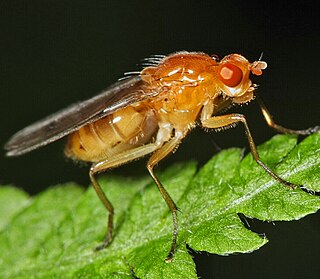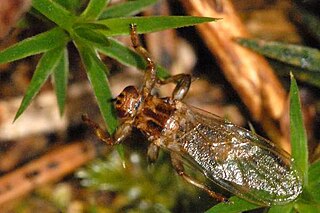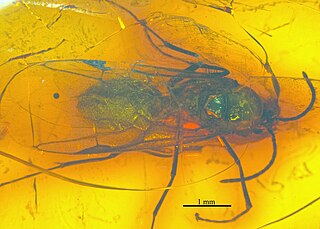Related Research Articles

Monotrematum sudamericanum is an extinct monotreme species from the Paleocene (Peligran) Salamanca Formation in Patagonia, Argentina. It is one of only two monotremes found outside Oceania.

The Dryomyzidae are a small family of flies ranging from 4–18 mm long, with prominent bristles, and yellow to brown or rust-yellow coloring. The wings are very large. The subcosta is complete and well separated from vein 1. Larvae feed on decaying organic matter - carrion, dung, and fungi. The prelambrum protrudes from the oral cavity. Vibrissae are absent and the postvertical bristles are divergent.

The genus Cathartes includes medium-sized to large carrion-feeding birds in the New World vulture (Cathartidae) family. The three extant species currently classified in this genus occur widely in the Americas. There is one extinct species known from the Quaternary of Cuba.

Andersonia leptura is a species of catfish of the family Amphiliidae, and is the only species of the genus Andersonia. This fish grows to about 50.0 cm (19.7 in) in total length; it is found in the Omo, Niger, and Upper Nile Rivers and the Lake Chad basin, and is also known from Lake Debo. Although previously considered to be toothless on the lower jaw, dentition has been found on the premaxilla and the dentary. The teeth are embedded in the mucous sheath that covers the head and extends into the oral cavity, which makes the teeth difficult to see with the naked eye.
Largirostrornis is a genus of enantiornithean bird. One species has been named, Largirostornis sexdentoris. It lived during the Early Cretaceous and is known from fossils found in the Jiufotang Formation in Liaoning province, People's Republic of China. Some researchers believe this species to be a junior synonym of the similar Cathayornis yandica.

Lepturinae, the lepturine beetles, is a subfamily of the longhorn beetle family (Cerambycidae), containing about 150 genera worldwide. This lineage is most diverse in the Northern Hemisphere. Until recently the subfamily Necydalinae was included within the lepturines, but this has been recently recognized as a separate subfamily. Nine tribes are usually recognized today, with a tenth, Caraphiini, created in 2016. A few genera are of uncertain placement within the subfamily.

Dasornis is a genus of prehistoric pseudotooth birds. These were probably close relatives of either pelicans and storks or waterfowl; they are placed in the order Odontopterygiformes to account for this uncertainty.

Ornithomya are genus of biting flies in the family of louse flies, Hippoboscidae. There are 29 known species. All species are parasites of birds.

Juliidae, common name the bivalved gastropods, is a family of minute sea snails, marine gastropod mollusks or micromollusks in the superfamily Oxynooidea, an opisthobranch group.
Oncopygius is a genus of flies in the family Dolichopodidae. It includes three living species in Europe, mainly recorded from montane habitats in Central and Southeastern Europe. Also associated with the genus are three extinct species known from fossils found in the Rott Formation of Germany, dated to the Oligocene.

Akimerus schaefferi is a long-horned beetle species (family. It belongs to the subfamily Lepturinae. This beetle is distributed in much of continental Europe, ranging from Iberia to Poland and Hungary, as well as in Bulgaria and Greece.
Paleobuprestis is an ichnogenus of bioerosion trace fossils found in wood that are thought to have been produced by the larvae of beetles in the family Buprestidae. It was first described by American paleontologist and park naturalist Myrl V. Walker in 1938, based on channels found just under the bark of petrified logs from the Petrified Forest National Park in Arizona, dated to the Late Triassic epoch. He described two different species of these markings: Paleobuprestis maxima for channels with a diameter of about 10 mm, and Paleobuprestis minima for those with a diameter of only 2 mm. Paleobuprestis has since also been recorded from the Upper Jurassic Morrison Formation and the Upper Cretaceous Price River Formation. In 2013, a third ichnospecies, Paleobuprestis sudeticus, was described from the Viséan-aged Paprotnia Beds in the Polish Sudetes. In 2006, Charles L. Bellamy established a new genus-group name Archeobuprestis for P. maxima and P. minima, considering the name Paleobuprestis to be unavailable under the International Code of Zoological Nomenclature because it was described after 1930 without a type species designation in its original publication.

Leptura is a genus of beetles in the family Cerambycidae, containing the following species:
Glipa longipennis is a species of beetle in the genus Glipa. It was described in 1905.

Pterotrigonia is an extinct genus of saltwater clams, marine bivalve molluscs in the family Megatrigoniidae. This genus is known in the fossil record from the Jurassic period Tithonian age to the Cretaceous period Maastrichtian age. Species in this genus were facultatively mobile infaunal suspension feeders. The type species of the genus is Pterotrigonia cristata.

Attopsis is an extinct genus of ants in the formicid subfamily Formicinae. While formerly containing a number of species, the genus is currently monotypic; the type species, Attopsis longipennis, is known from a single Early Miocene fossil found in what is now Croatia.

Mesosa is a genus of longhorn beetles of the subfamily Lamiinae, containing the following species:

Dolichoderus longipennis is an extinct species of Eocene ant in the genus Dolichoderus. Described by Mayr in 1868, the fossils were discovered in the Baltic Amber.

Helorus is a genus of wasps in the family Heloridae. There are about 12 described species in Helorus, found worldwide Members of the genus are parasitic on green lacewings. The oldest fossils are from Eocene aged Baltic amber.

Dendroleon is a genus of antlions in the family Myrmeleontidae. There are more than 20 described species in Dendroleon.
References
- ↑ Vitali, Francesco (2005). "Notes about European fossil Lepturinae and the description of a new species (Coleoptera, Cerambycidae, Lepturinae)". Lambillionea. CV (4): 530–538. CiteSeerX 10.1.1.626.9431 . Archived from the original on 20 June 2024. Retrieved 7 April 2024.
- ↑ BioLib Archived 28 May 2019 at the Wayback Machine Taxon profile — species Leptura longipennis Statz, 1938 †
- ↑ Leptura longipennis Archived 12 December 2021 at the Wayback Machine at Fossilworks